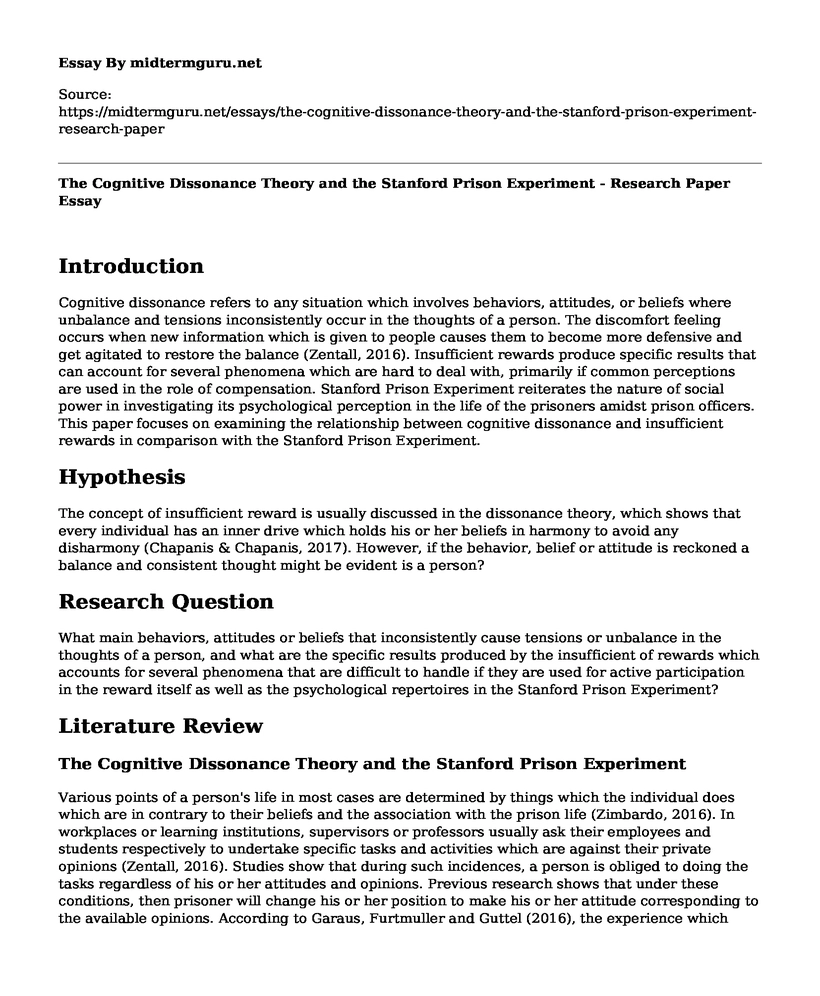Introduction
Cognitive dissonance refers to any situation which involves behaviors, attitudes, or beliefs where unbalance and tensions inconsistently occur in the thoughts of a person. The discomfort feeling occurs when new information which is given to people causes them to become more defensive and get agitated to restore the balance (Zentall, 2016). Insufficient rewards produce specific results that can account for several phenomena which are hard to deal with, primarily if common perceptions are used in the role of compensation. Stanford Prison Experiment reiterates the nature of social power in investigating its psychological perception in the life of the prisoners amidst prison officers. This paper focuses on examining the relationship between cognitive dissonance and insufficient rewards in comparison with the Stanford Prison Experiment.
Hypothesis
The concept of insufficient reward is usually discussed in the dissonance theory, which shows that every individual has an inner drive which holds his or her beliefs in harmony to avoid any disharmony (Chapanis & Chapanis, 2017). However, if the behavior, belief or attitude is reckoned a balance and consistent thought might be evident is a person?
Research Question
What main behaviors, attitudes or beliefs that inconsistently cause tensions or unbalance in the thoughts of a person, and what are the specific results produced by the insufficient of rewards which accounts for several phenomena that are difficult to handle if they are used for active participation in the reward itself as well as the psychological repertoires in the Stanford Prison Experiment?
Literature Review
The Cognitive Dissonance Theory and the Stanford Prison Experiment
Various points of a person's life in most cases are determined by things which the individual does which are in contrary to their beliefs and the association with the prison life (Zimbardo, 2016). In workplaces or learning institutions, supervisors or professors usually ask their employees and students respectively to undertake specific tasks and activities which are against their private opinions (Zentall, 2016). Studies show that during such incidences, a person is obliged to doing the tasks regardless of his or her attitudes and opinions. Previous research shows that under these conditions, then prisoner will change his or her position to make his or her attitude corresponding to the available opinions. According to Garaus, Furtmuller and Guttel (2016), the experience which involves engaging in behaviors which are contrary to one's private attitudes refers to dissonance (Garaus, Furtmuller & Guttel, 2016). Other studies also show that people usually strive towards consistency on certain duties within themselves as well as their lives to get rewarded (Chapanis & Chapanis, 2017). As a result, several research studies conclude that the inclination of engaging in certain behavior after removal of extrinsic rewards is not the intended functions of the past rewards.
Research Methodology
Sampling Method
The Cognitive Dissonance Theory and the Stanford Prison Experiment
Thirty undergraduate students, both male, and female ate ending the local college were sampled to participate in the research study. The sampled students were third and fourth-year students from Wario College and prisoners (Zimbardo, 2016). The students were between age's twenty-two and twenty-four years old, respectively; fifteen male and five females (Harmon-Jones & Harmon-Jones, 2018). Different names were given to the participants before they are subjected to a series of questionnaires to determine the actual reason behind the perceived attitude or beliefs in behavior.
Results
The outcome from the responses which were given by the student's shows that dissonance reduction method can cause significant insufficient reward among employees or students (Zimbardo, 2016). Cognitive dissonance theory explicitly explains the relationship behavior and social recognition. It provides a significant relationship between employees and their employers for a meaningful reward.
Conclusion
The cognitive dissonance theory asserts that if a person is held between different ideas or beliefs, his or participation is jeopardized. However, Stanford Prison Experiment maintains that the investigation of the psychological effects on the perceived power between the prison officers and the prisoners can only be made by adding new elements or changing the cognitions. Overall, the insufficient reward is built from perceptions which most participants are subjected to in their daily activities.
References
Chapanis, A., & Chapanis, N. P., (2017). Cognitive dissonance: Five years later. In Attitude Change (pp. 116-153). Routledge.https://www.coursehero.com/file/p3jkvv8r/The-Journal-of-Finance-71-1-267-302-Chapanis-A-Chapanis-N-P-2017-Cognitive/
Garaus, C., Furtmuller, G., & Guttel, W. H. (2016). The hidden power of small rewards: The effects of insufficient external rewards on autonomous motivation to learn. Academy of Management Learning & Education, 15(1), 45-59. https://pdfs.semanticscholar.org/07b2/0e21fbb563b41cceff2d9b9e6b2a243060ed.pdf
Harmon-Jones, C., & Harmon-Jones, E., (2018). Toward an Increased Understanding of Dissonance Processes: A Response to the Target Article by Kruglanski et al. Psychological Inquiry, 29(2), 74-81. https://www.unsworks.unsw.edu.au/primoexplore/fulldisplay?vid=UNSWORKS&docid=unsworks_modsunsworks_54737&fromSitemap=1
Zentall, T. R. (2016). Cognitive dissonance or contrast?. Animal Sentience: An Interdisciplinary Journal on Animal Feeling, 1(12), 1. https://animalstudiesrepository.org/animsent/vol1/iss12/
Zimbardo, P. (2016). Revisiting the Stanford prison experiment: A lesson in the power of situation. Perspectives on Contemporary Issues, 309-317. https://www.chronicle.com/article/Revisiting-the-Stanford-Prison/9676
Cite this page
The Cognitive Dissonance Theory and the Stanford Prison Experiment - Research Paper. (2023, Jan 15). Retrieved from https://midtermguru.com/essays/the-cognitive-dissonance-theory-and-the-stanford-prison-experiment-research-paper
If you are the original author of this essay and no longer wish to have it published on the midtermguru.com website, please click below to request its removal:
- Discussion Question on the Development of International Human Rights - Paper Example
- Borderline Personality Disorder Case Study Paper Example
- Article Analysis Essay on Culture as a Social Determinant of Mental and Behavioral Health
- A Summary of a Research Paper on the Relationship between Bipolar Disorder and Cannabis Use
- Early Childhood Interest in Law - Essay Sample
- Juvenile vs Adult Courts: Comparing a Case Study - Essay Sample
- Personality Development: Foundations, Features, and Influences - Essay Sample







